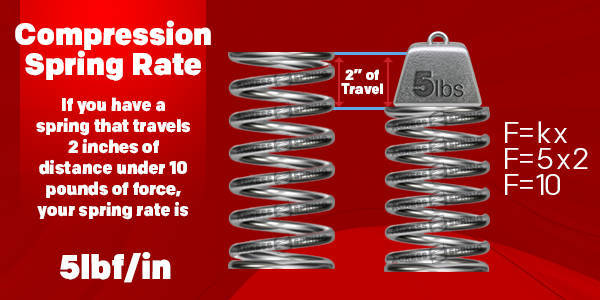The Importance of Max Safe Travel and Max Load
The Importance of Max Safe Travel and Max Load
Maximum(Max) Safe Travel = Elastic Limit
When it comes to springs, the terms “maximum safe travel”, “elastic limit” and “taking a set” can be a little confusing to understand because they are all related. These terms are all related to the importance of respecting the limits of deflection that each spring has. This is why the following article will explain the importance of respecting the maximum safe travel and max load so that you don´t permanently damage your compression spring.
Springs can be compressed, extended, or torqued to a certain point before they go past their elastic limit. . Since each spring design is different, it is very important that you know the elastic limits of the specific spring you are using.
The elastic limit of a spring
For Example on Compression springs. We have a compression spring that has a 1.000 Free Length with 0.250 max safe travel. We compress the spring past 0.250 travel all the way to 0.500 which happens to be our solid height. We clearly went past the max safe travel by 0.250. We release the load on the spring and since we went past our max safe travel distance of 0.250 our spring “took a permanent set” and will not return to its original Free Length of 1.000. The spring only returns to a 0.750 Free Length . Why? Because you went past its elastic limit (max safe travel) and the spring “took a permanent set” and will never return to its original free length. In other words we just ruined our spring because we will no longer reap the benefits of a spring with long life because we went past its max safe travel.
It is imperative that you Never go past a spring's elastic limit because if you do the spring will take a permanent set because you overstressed the physical limits of the spring.
The force chart to the right explains the adjustments you can make to your spring design to increase or reduce its force. The stronger and stiffer the spring, the more stress it is being put through, thus giving you less travel. A spring not as strong will have less stress and more safe travel. (please use standard force chart found on our spring calculator)

Compression Spring Max Load
When working on a compression spring design there are several key factors. The first factors are the physical dimensions ensuring your spring appropriately fits into your design or product. Your spring’s working loads are another component that you have to consider. So ask yourself, can your spring handle the load and travel you will place on it? How do you know? The answer is easy. All you need to do is go into our Spring Creator calculator and input the measurements of your spring, it will automatically give you an analysis of the spring. In the analysis, go to the section of “rates and loads” and look at “maximum safe travel”. You need to respect this value if you want your spring to work right and have a longer cyclic life.
How to Calculate Compression Spring Load
Let's say a compression spring's free length is 1 inch and, based on how thick the coils are, you can physically compress it down to the solid height of 0.5 inches. Does this mean you should? It depends. If the spring’s maximum safe travel is 0.75 inches it means you can make the spring travel down all the way to the solid height of 0.500 inches without any problem. However, if the spring’s maximum safe travel is only 0.250 inches, you will only be able to safely compress it down to a loaded height of 0.750 inches without it taking a set.
Let's put it this way, if you ignore a spring's maximum safe travel and press down a compression spring past this elastic limit, it will go down, but it will have endured so much pressure that it will take a permanent set. Which means the spring loses free length which equals loss of travel and therefore loss of load. So lets recap, since our spring took a permanent set and does not return to its original free length we lose distance travel and since we can't travel all that distance anymore we lose load and force. To check your spring's max safe travel distance go to our Spring CreatorCalculator and input your spring specs here.

Load Formulas
The formula to calculate load on compression springs is as follows:
(k) Rate x´s Distance Travel (deflection) = Load
A Springs rate can be either in Lbs/in or N/mm

Try our Spring Creator calculator today and take a look at the free spring analysis it generates. If you need additional help or assistance in finding the ideal spring contact us today: (951) 276-2777.






